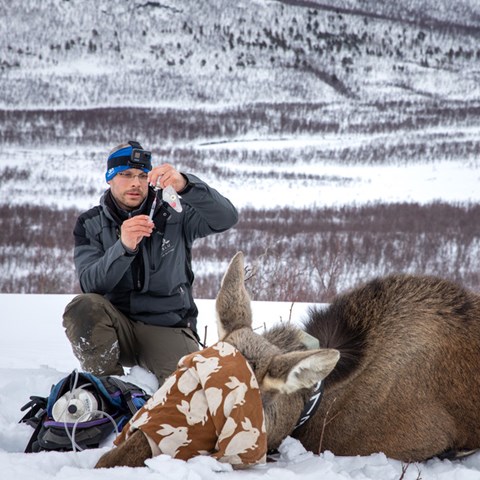Contact
Department of Wildlife, Fish and Environmental Studies

Our research is about the relation among animal, human, and plants, and is both basic and applied. Examples of current research topics are plant-animal interactions, movement behavior such as migration between summer and winter areas, diet, home ranges, habitat selection, utilization of the landscape, reproduction and survival, human disturbance effects, physiology, and climate effects. We study systems both in southern and northern Sweden, covering latitude 56 to 67.
Close cooperation with the surrounding community is a general feature of our research. We study how our activities affect wildlife, and how do wildlife affect our behavior and us? Our group also studies how wildlife experience different types of human activity like hunting and outdoor activities. Who is most afraid - the human or the bear when we meet? Or how does moose and reindeer react to mines and wind power parks in the landscape? How do they utilize the common Mountain landscape? How do the large forest fire fields affect the reproduction and distribution of moose in the landscape that forest fires in 2018 left behind in the Ljusdal municipality? How do moose utilize an archipelago environment in the Baltic Sea?
The research program BEYOND MOOSE studies the interactions between ungulate species in multi-species systems in relation to the surrounding landscape, how the species affect and are affected by forest and agriculture, and what they forage on. The program works closely with the GOVERNANCE program, which works with the conditions for future wildlife management.
Forage and forage utilization as well as improved methods for monitoring wildlife impacts are key issues for us. An important research question is what a "hotspot" - a natural area that is used repeatedly - really is and what it means to both animal people.
Another point of departure in our research is to understand how the current climate change affects humans and animals. Another central point in our work are traffic safety issues, and where we work to better understand the factors that affect the risk of wildlife-vehicle collisions in time and space using animal movement and collisions data.
The Department of Wildlife, Fish, and Environmental Studies (formerly Forest Animal Ecology) at the University of Agricultural Sciences (SLU) in Umeå has a long tradition of research on wild mammals and birds in general, and moose in particular.
An exciting topic is landscape's production possibilities of game and fish from a multicultural perspective. What game and fish species should we invest in? Which species are best suited in a particular landscape? Knowledge that can be of great importance to individual, often smaller forest companies, weighing between different types of land use, where game or wildlife and fishing tourism can be one.
The goal of our more applied research are to produce new knowledge that becomes available to anyone interested in managing our natural resources where wildlife and plants are central. Collaboration has priority for us. An important function for the group is therefore to act as a platform for dialogue and collaboration between researchers, other actors and the surrounding community.
Please check for more specific information about the different members of the group here: people